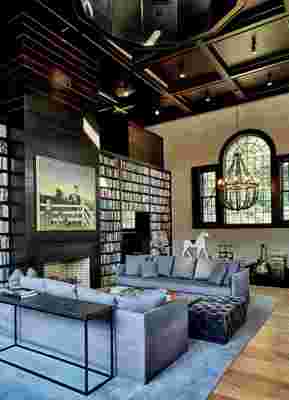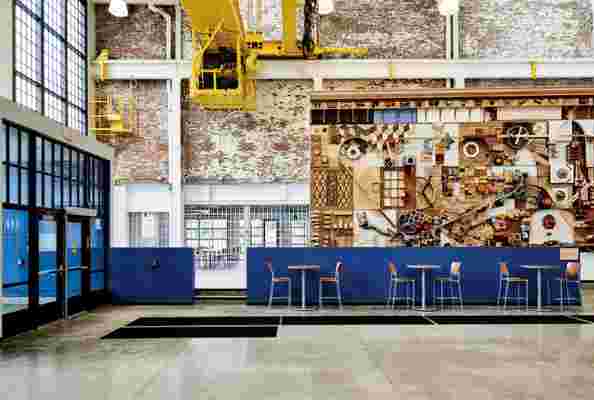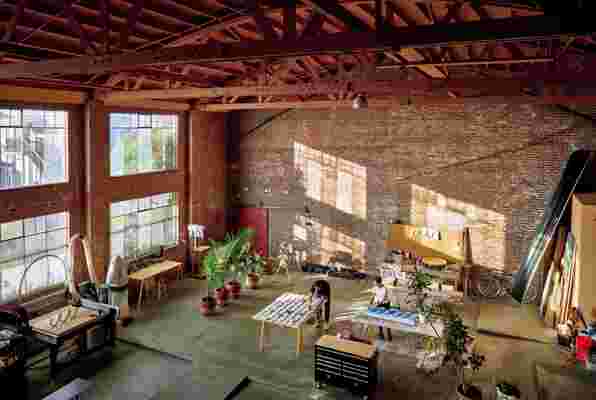Cool is everywhere, claims photographer Michel Arnaud. The statement is the title of his newest book ( Abrams , $35), a survey of 14 second- and third-tier American cities experiencing a creative surge, particularly by way of adaptive reuse projects.
Long fascinated with postindustrial metropolises and the way they reinvent themselves, Arnaud first focused his attention on Detroit , leading to his 2017 book, Detroit: The Dream Is Now ( Abrams , $40). “Being in Detroit was an eye-opener. It changed the way I looked at other cities,” says Arnaud. “As I traveled across the country, I noticed other cities were revitalizing, and adaptive reuse was at the core of this reinvention. In many cases, those projects paved the way for new design thinking.”
The photographer had witnessed a rising trend in the country’s largest cities, such as New York, Chicago, and Los Angeles: Young creatives were leaving, driven out by the high cost of living, particularly regarding real estate. “Young artists and entrepreneurs were moving to or returning home to what could be described as forgotten cities,” says Arnaud. “But these cities had previous lives and histories that were fascinating and important, and the existing architecture and structures left behind from their earlier heyday was and still is ripe for revitalization.”
So the photographer journeyed to all four corners of the continental United States, documenting both public and private projects in these once-forgotten cities that gave new life to old spaces. While some are what you might anticipate from adaptive reuse projects—say, old warehouses transformed into loft-style apartments—others were delightfully unexpected. “Old Glory in Nashville was a shock. No one would describe the space to me before I went, but I was told it was the coolest spot in Nashville,” says Arnaud. “To find the place, I walked down this nondescript back alley to an unmarked door. I couldn’t believe it. The owners had taken an abandoned, forgotten 1920 boiler room of a now-defunct dry cleaner and turned it into a chic cocktail bar and restaurant.”
Discover 10 other projects that captivated Arnaud during his exploration, as found in the pages of Cool Is Everywhere: New and Adaptive Design Across America.
Terry Iwaskiw and Melinda Lehman Residence, Greenville, South Carolina

“I was totally surprised by Terry Iwaskiw and Melinda Lehman’s residence in Greenville, South Carolina,” says Arnaud. “They transformed a building that had quite a history—first as a synagogue, built in 1929, then as a church and then a photographer’s studio—into an amazing home.”
Northland Workforce Training Center, Buffalo

Some adaptive reuse projects focus on social good. In upstate New York, the former Niagara Machine & Tool Works factory complex was converted into the Northland Workforce Training Center to provide education and professional support for students with financial need. The wooden mural is by Dennis Maher and the SACRA program of Assembly House 150.
Mei-Lan Tan and Victor Lefebvre Studio and Residence, Oakland

Designers Mei-Lan Tan and Victor Lefebvre occupy a 6,000-square-foot former factory that now serves as their studio and residence.
Portland Japanese Garden, Portland, Oregon
Not all adaptive reuse projects focus on converting interior spaces. The Portland Japanese Garden in Portland, Oregon, sits on the former site of a zoo.
Quirk Hotel, Richmond
The vaulted ceiling and the iron staircase at the Quirk Hotel in Richmond are original to the building, which was constructed in 1916 as a department store.
Mobelux, Richmond
Virginia digital design agency Mobelux has quite a unique office, set inside an 80-year-old former post office in Richmond.
Vadis Turner and Clay Ezell Residence, Nashville
Artist Vadis Turner and her husband, Clay Ezell, live in a former commercial building, but thanks to their use of patterned textiles, lush fronds, and dozens of artworks, their house feels quite warm and homey.
Michael Olijnyk Residence at the Mattress Factory, Pittsburgh
As you might guess, the Mattress Factory, a museum in Pittsburgh dedicated to installation art, is housed in a former mattress factory. But what you probably didn’t know is that the museum’s founders, Michael Olijnyk and the late Barbara Luderowski, lived together on the top floor of the space.
Union Station, Denver
Train stations across America are some of the country’s grandest works of architecture, and although trains don’t necessarily run through them anymore, they’re still enjoyed by thousands, thanks to adaptive reuse. In Denver, Union Station has become much more than a terminus for the light-rail service to the airport—it’s home to eateries, shops, and even a hotel.
Cool Is Everywhere: New and Adaptive Design Across America by Michel Arnaud.
